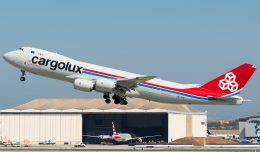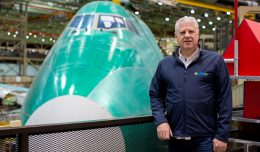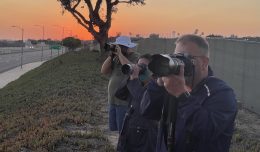Captain Barrington Irving is well known within the aviation industry. At age 23, he became the youngest person to circumnavigate the globe in a Columbia 400 named “Inspiration.” The aptly named aircraft has served its name to the next ventures in Captain Barrington’s career: the launch of The Flying Classroom and Experience Aviation. This new venture is based out of Miami-Opa Locka Executive Airport.
The city of Opa-locka, with a population of just over 16,000 residents was founded in 1926 by aviation pioneer Glenn Curtiss. It is located in Miami-Dade County in South Eastern Florida. Within the city limits can be found the joint civil-military operated Miami-Opa-locka Executive Airport. This is an 1,880 acre facility with 3 runways and full FBO services including aircraft repair and maintenance. It is also home to the busiest U.S. Coast Guard Air/Sea Rescue Station.
In September 2023, the city of Opa-locka and the Barrington Irving Technical Training School (BITTS) launched a cooperative program. This program will provide a workforce education program that guarantees jobs for city residents in the aviation field. This one-of-a-kind program will utilize the facilities of Captain Irving’s Flying Classroom to provide students with all the technical training and job-ready skills to enter the aviation industry. This training is being provided at no cost to the students. The facilities located at Miami-Opa-Locka Executive Airport give students the ability to witness first-hand the workings of the industry. Airport tenants including Signature Aviation and Bombardier are providing support for the Flying Classroom. In addition, they are hiring students after they complete the course.
NYCAviation was very fortunate and privileged to be able to talk to the two driving forces behind this venture, Opa-locka City Manager Darvin Williams and Captain Barrington Irving. They gave us more insight into the establishment of the joint venture, the vision they both have, and the future of the program.
An Interview With Barrington Irving and Darvin Williams
NYCA: Captain Irving, thank you for your time to be able to talk about this amazing program. Obviously, this goes back to when you starting flying and saw a need in the industry to be able to educate people. Can you please give a bit of background as to how you first thought about this?
BI: When I flew around the world, back then we knew we needed to get more people involved. After that, I was doing hands on projects with students here at Opa-locka Airport through my non-profit organization. We were working to get kids to pursue different careers in the field. It wasn’t until about 2010 or 2011. I said to myself, we need to do more and take the approach of having students replicate elements of what adults do. So we started to get kids to build airplanes. We then expanded that to having kids build high performance race cars. Then it expanded to solar go-karts and boats. I realized at that point, we need to do more. We need to get directly into the classroom. At the time, aviation was maybe an ancillary after school program, and so at that point I created Flying Classroom. At that point, manufacturers came to me and asked if I could take what I was doing for kids and do it for adults. I resisted at first, because I wanted to perfect what we were doing.
Just prior to COVID, I was approached by Bombardier in Canada who wanted to really move forward with the idea and my reply was that I would only do it if I could do it my way. The industry was crying out saying that they have a recruitment issue. I didn’t agree with that, I said that the industry has a marketing issue. That is, we really need a way to engage an audience to want to even consider this field as a career. We also have a message issue. If you want to become a pilot or a technician, there isn’t really a straight way that the path is explained. Aviation hasn’t really done a good job of explaining the career paths. I started to see an underlying issue that exists in our industry and that is, yes, we are getting people that have certificates, but it doesn’t necessarily mean that they are competent.
NYCA: In other words, a piece of paper is one thing, actual experience is a different thing?
BI: The industry wants competency even more than they want a certificate, even though the certificate is a necessary by-product. When I started to observe that, that became my niche. How do I focus on competencies? How do I focus on really preparing an individual? Everyone talks about recruitment, no one talks about attrition. We live in a world now where if you get a technician, you better hold onto him as long as possible. It’s so ironic in the we say that we need people in the industry and we say we need quality people but there are two key populations that we don’t pay attention to. Even in education, we are incentivized to support students who make A’s in school or who are failing in order to help them. I realized that no one pays attention to the B, C and D students and that is the majority of who we work with. Yes, we work with A students, but to some degree it doesn’t matter how book smart they are. They might struggle with hands-on technical skills whereas the lower grade students, the B and C type students tend to thrive a more with the hands-on skills. So we are potentially missing out on a good deal of the population.
The other group we are missing out on is the age group say from ages 21 to 45 or so. They might be employed, they might have jobs. But they don’t have the ability, knowledge or guidance to upscale themselves or make a pivot into our industry. For example, I might be a 30 year-old that is employed but who has no background in aviation. I drive past an airport and it intrigues me. However I don’t know the first place to start outside of college or a technical school. Meanwhile, you have companies that are looking for willing, dedicated individuals who might not even need a certification, or smaller certification skills that takes a few weeks or months. These companies are more than willing to hire them. This is what I started to pay attention to. I am not trying to be the next Broward College or George T. Baker Technical School. I have realized the real niche is upscaling communities. It’s short term and accessing a unique population of people that aren’t as easy to access and involving them in our industry. This advancement of the community is definitely a culture change.
NYCA: That seems to be more pertinent hosting it in Opa-locka where you have a large population right there. Opa-locka is unfortunately a city where the news to come out of the community is not always the best news. There are a lot of people there that want to advance in life, want to be able to provide better for their families. That provides the potential for a large number of students for the program.
BI: In a lot of cities, airports are located adjacent to Opa-locka type environments. Instead of distancing themselves from the environments that these communities are unfortunately known for, there is so much potential within that community that is simply untapped. We currently have a program where 5 local partners, whose names are well known in the industry, have 20 jobs waiting for candidates, so what we are doing is providing specified training for the needs of these different partners. Candidates go through a learning phase of 10 weeks and then they go out for a period of time that is on the job training and they have the ability to get a job and flourish and grow their career. But you have to have that support mechanism. We are not only doing this for the community, but also for a few individuals that are transitioning back to society for non-major crimes. They are some of our highest performers because they want another chance at life.
NYCA: You have a market of people that can really sustain large numbers to be able to benefit from your program.
BI: Yes, and part of our secret really is making it exclusive. One of the biggest mistakes our industry is making is that because they are so desperate, we just need anyone that can do the task. We are working with human beings here. Make them feel special, make it feel that you are appreciated. One of the first things we have done with our candidates is ask them, “have you ever taken a personality test? Do you know who you are and what you like? What are your strengths and weaknesses?” It is so fulfilling for an individual to see what their personality characteristic is, what are my interests that show through. When you treat people like people and not like a number that is on an aircraft part, it makes a world of difference packing some exclusivity around them. It started with 10 people, that turned into 30, 30 has turned into 160 people.
NYCA: How is this all growing at the moment?
BI: The city of Opa-locka has provided us with 4 acres of land, to go along with the 3 acres that is currently provided by Miami-Dade County and asked what we can do with it. My plan at the moment is, warehousing is a massive shortage in the industry and you also have people that are looking to be able to do various type of repairs or overhauls in the area. So why not pursue having some type of MRO facility here and the company does their professional operations. On the second or third floor, you can create an on-the-job training facility. Not everyone will be hired but you have the direct ability to start training people. It is too much for a for-profit company to try and start unless you are one of the major industry leaders. These are the type of strategic collaborations where the benefit is for the company, but also for the community. Incentives are being created for the potential employers as well, but the key is the specified training and the time to build that out. The hard part is implementing it and making it rigorous enough where you don’t want to discourage people, but build people up and allow them to thrive in the community and to thrive in the company as well.
NYCA: Mr. Williams, thank you for the opportunity to speak to speak to you. After receiving all the information about the project and talking to Captain Irving, it really is a privilege to be able to talk to you because this really is a unique opportunity.
DW: We are truly excited about it to be able to talk about the opportunity. How we can get the word out, how we can expand it, and how we can highlight it so that maybe other municipalities can incorporate aviation and mechanics and this unique opportunity for training into their models as well.
NYCA: How did you first get involved with Captain Irving and this program?
DW: As you probably know, Flying Classroom is located within the city limits of Opa-locka. As the new City Manager, I made it my business to go out into the community to find out what the residents are doing What the needs of the residents are, what businesses are doing and what their needs are. That is how I was introduced to Captain Irving.
NYCA: Captain Irving refers to his program as a culture change. Do you see that in the city of Opa-locka?
DW: Absolutely. We have a pretty archaic law in our charter, and this is to promote the hiring of Opa-locka residents. I have really tried to follow the spirit of the law. One of the first things that I did was to implement in development agreements for new construction coming into the city. We put in a requirement that they have a job fair for Opa-locka city residents to try and get them hired. It was exciting for the residents, for the city and for the companies involved. However, we found unfortunately that a lot of the residents did not have the appropriate background and training to get it done. What Captain Irving is doing is really filling a huge gap between a demand and a need which is always needed for a road to success. So we have the interested residents. We know there is a huge employee shortage in this industry. Captain Irving has put together a unique program that I know is going to take off because of the interest that we have found with it that is going to bridge that gap. I am very excited that the city of Opa-locka can be part of this journey.
NYCA: It is easy in a way because you have the airport right there in the city and you have support mechanisms right there, and Opa-locka airport is a huge airport.
DW: It is a huge airport. People in the industry know that, but outside of the industry, it is not well known. From statistics that I have for flights, Opa-locka is 10th in the nation and 12th in the world in international traffic. So yes, for what they are doing at the airport, it is tremendous.
NYCA: Obviously feeding people from the program into the airport, you have everything. They live in Opa-locka, they work in Opa-locka, there is pride in their community now.
DW: Most definitely! So, I do agree with Captain Irving’s statement, it is a culture change or a culture shift.
NYCA: Do you see this type of program expanding in Opa-locka to other industries in the city? Do you think you will be able to champion other industries knowing what is going on with this program?
DW: Yes, we are already having that discussion. We are looking at expanding this program to other industries. We are looking at some mass production and we are looking at development a training program on that side.
NYCA: That is good for the city as a whole. You have a large population that typically have not had access to these types of programs. Yes there are 2- and 4-year colleges close to the area, but those cost money. People from Opa-locka have not always been able to afford that type of education in any industry.
DW: Yes, for those reasons exactly, this is going to be a game changer.
NYCA: What have you seen so far as the feedback from the residents that have been through the program?
DW: I think it is still new and so because of that there seems to be a perception that this is going to go away. If you didn’t get into it, you don’t have the opportunity. But we are promoting every class as though it is the first one. We are ready for that ground swell so that people get comfortable with it. The numbers show at the moment that the average household income for a family of 3 in the city is around $36,000. If one member of a household gets a job from the program, the household income can more than double. When that information is spread around the community, this will become a staple that people will rely on and look towards for furtherment.
NYCA: Programs such as this can only grow a city that, in all honesty, hasn’t always been seen in the best light over the years.
DW: While I have not been in my position that long, just short of two years, that has been a major hurdle and concern of mine. I am addressing that head on. We are doing a lot of firsts across every department. That is what this is, it is a transformation. We are transforming the community, transforming the reputation and transforming the perspective. We have just been through one of the longest crime free periods in the city. That only goes to show that we are making a change in the city, a transformation.
NYCA: While it would be perfect for people in the program the work in their home city, the aviation industry is huge in South Florida. So people working in other locations need the infrastructure to be able to get to and from work, and that does exist.
DW: Yes, but we are making changes to that as well. I am currently in negotiations to provide free transportation from residents’ homes to public transportation hubs. Services like Brightline, the TriRail system, the public bus system can get you anywhere in the city. In fact one of the things we are addressing is for people at Captain Irving’s school. The nearest public bus stop is a 30 minute walk from the facility. So we are looking at putting in free transportation to take them from that bus stop right to the door of the facility. We are doing everything to facilitate the program and grow it.
NYCA: The program is growing in support from industry leaders. You are providing the support for your residents, it is a win-win for everyone.
DW: It absolutely is and that is what makes this so exciting. There is not a stakeholder that does not benefit from participating in the program.
The author wishes to thank Captain Irving and Mr. Williams for their time in completing the interviews for this article.







